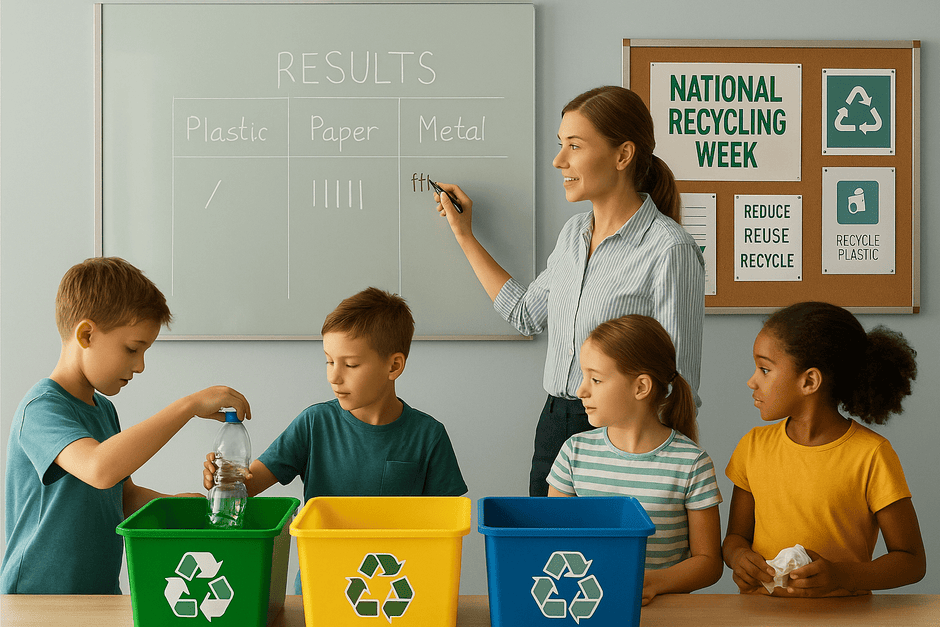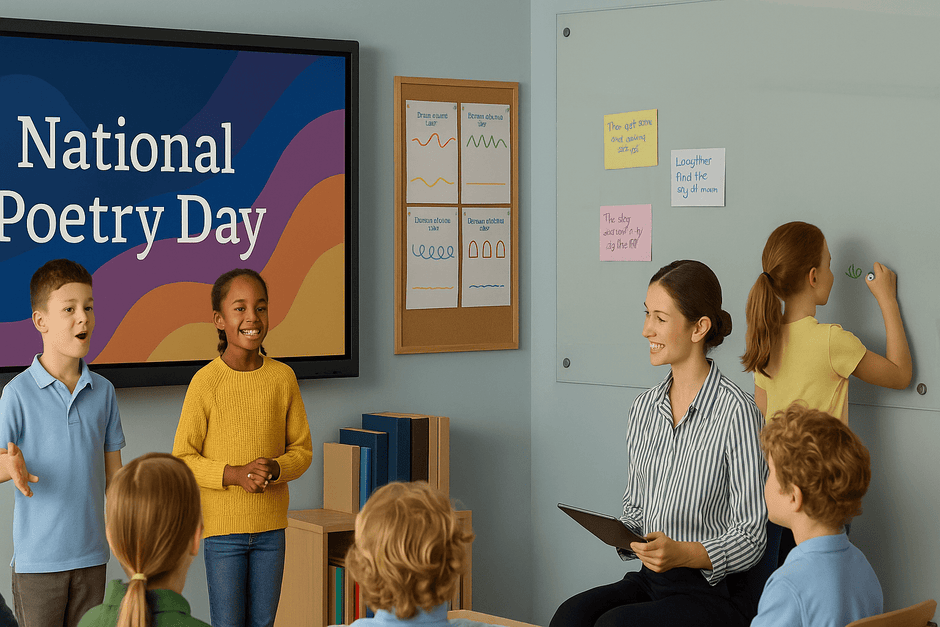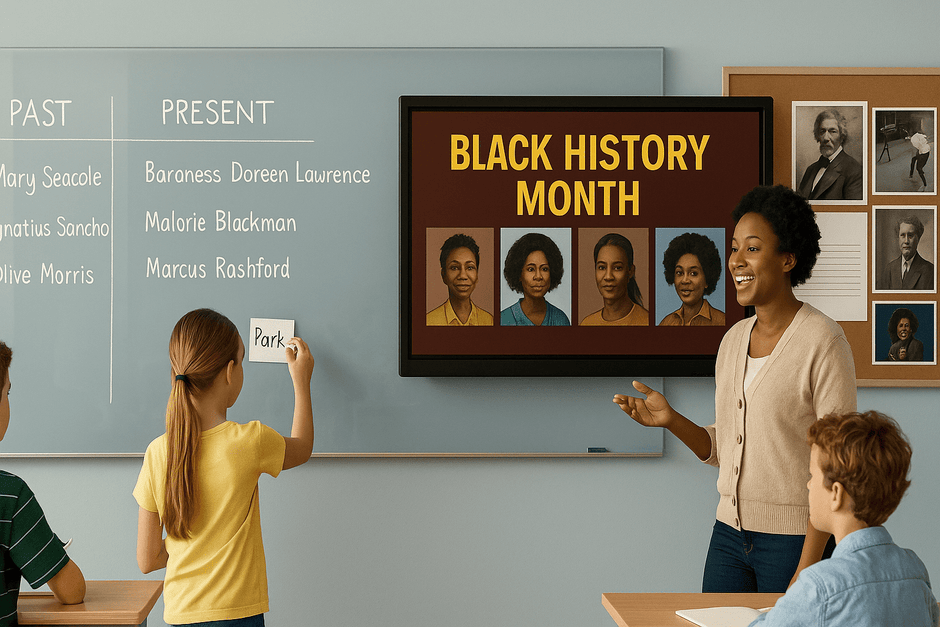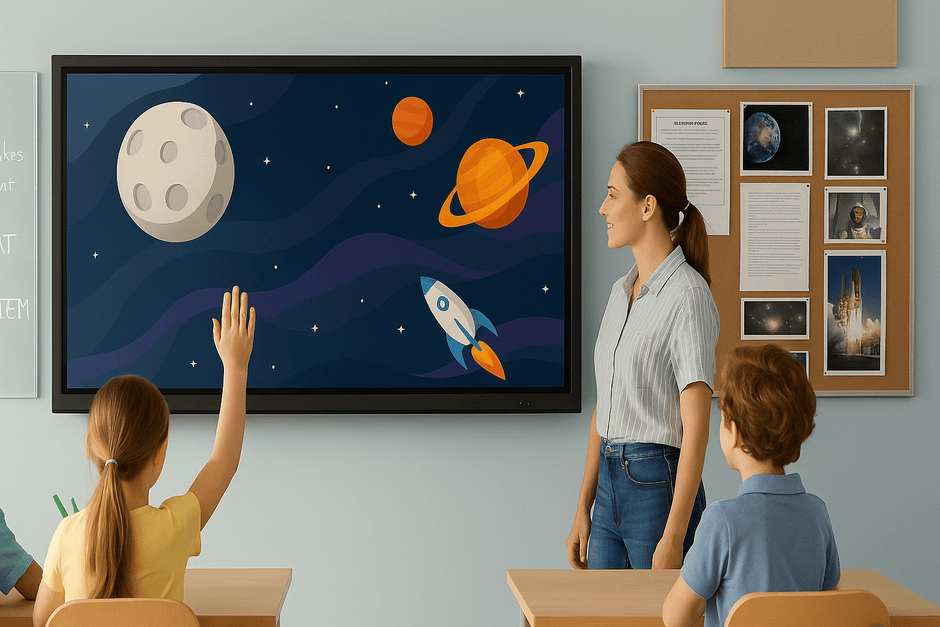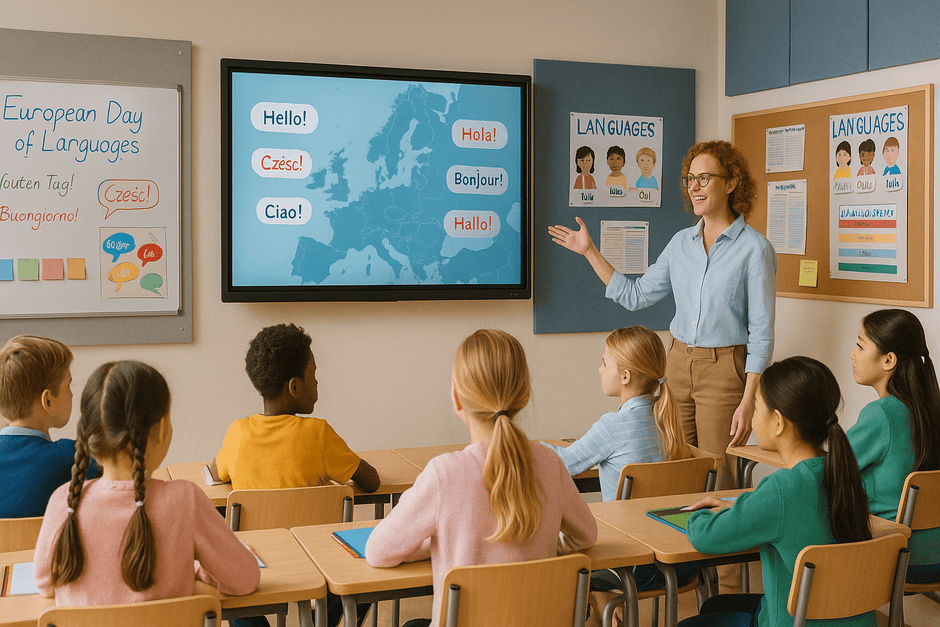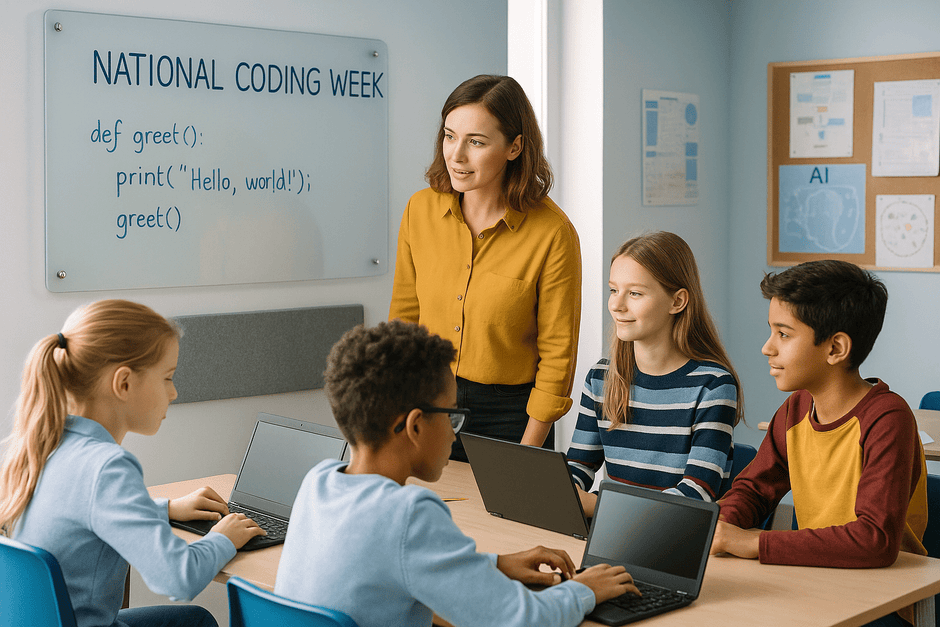The last week before October half-term can feel a little stop-start. Energy dips, routines wobble, and everyone is ready for a well-earned rest.
The good news is that you don’t need to push harder to keep learning on track – you just need calm, purposeful activities that consolidate what pupils already know, celebrate progress, and tee up a smooth return after the holiday.
Below you’ll find a ready-to-use set of lesson ideas, routines, and whole-school approaches designed for the final five days. Everything here is low-prep, flexible, and inclusive. Where it helps, we’ve highlighted classroom tools that make delivery easier – visualisers for reading together, adjustable interactive systems for group problem-solving, and display surfaces for quick reflections. As always at Presentation Spaces, every product is hand-picked by our MD, Joe, for suitability and durability in UK schools, and we won’t be beaten on price. Free delivery on most items.
Why momentum matters in the final week
- Memory and confidence: Short, well-structured tasks help pupils consolidate knowledge so that less is “forgotten” over the break.
- Routine and wellbeing: Familiar rhythms lower anxiety and make the return after half-term feel natural rather than jarring.
- Belonging and pride: Publicly celebrating small wins – on a corridor noticeboard or class display – builds motivation right up to the last bell.
Think of the week as a soft landing: purposeful, positive, and focused on showing what pupils can already do, not introducing heavy new content.

How to use this guide
- Pick 1–2 ideas from each theme and repeat them across the week rather than changing every day.
- Keep instructions simple and visual. Present steps on a whiteboard and tick them off as you go.
- Show work quickly to the whole class with the AVerVision F17+ visualiser for immediate feedback.
- Collect outcomes in one place – a noticeboard becomes your “Half-Term Highlights” wall.
Literacy – short, satisfying tasks that build fluency
1) Reading Relay
Choose a short text or chapter. Pupils read in pairs for 2 minutes, swap, and note one favourite line each.
Setup: Project the text under the visualiser so everyone sees the same page. Invite quick shares and pin favourite lines on a noticeboard.
2) Micro-Write Challenges
Offer a tiny prompt – ‘Describe a sound in five lines’, ‘Write a six-sentence summary’, ‘One paragraph from a different character’s view’ – to practise precision.
Tip: Model one live under the visualiser. Use a pastel writing surface to reduce glare and support focus for SEND learners.
3) Class Anthology
Across the week, collect pupils’ best short pieces (poems, mini-reviews, one-page reports). Curate them as a gallery.
Display: Mount clean copies on a central noticeboard or present digitally on an interactive screen for a mini launch party.
STEM – quick investigations that channel curiosity
4) Paper Plane Showdown
Groups design two planes, predict which will fly furthest and why, test three launches each, then average results.
Tools: Record distances and averages on a big whiteboard or move planning between tables with a rollerboard. Use the visualiser to show folds clearly.
5) Mini Data Hunt
Pose a simple question: ‘Which break-time snack is most popular?’ or ‘How many steps from classroom to hall?’ Pupils plan a fair data collection, gather results, and present one clear chart.
Presenting: Chart templates on glassboards keep lines crisp and readable.
6) Maths Escape Cards
Set a chain of 8–10 short problems around the room. Each answer reveals the location of the next card.
Access: Anchor the master puzzle on a height-adjustable Flexi-View Interactive Column Board so all groups can check progress without crowding.
Humanities – reflect, connect, and display
7) Timeline Tidy-Up
Give mixed facts from this term’s topic. Teams build an accurate timeline and add one picture or quotation to each event.
Display: Create a corridor line on a long noticeboard so families can view it at pick-up.
8) Places & Spaces – map gallery
Pairs create one beautiful, annotated map each – a city, river system, or fieldwork site – with three ‘what changed my mind’ reflections.
Modelling: Use the visualiser to show annotation quality and symbol keys.
9) Debate-Lite
Low-stakes speaking: 3 minutes to prepare, 60 seconds to speak, 30 seconds for a counterpoint. Topics link to curriculum questions you’ve already explored.
Access: Present at a comfortable height using the Flexi-View. Capture key phrases on a whiteboard so quieter pupils can contribute by adding notes.
Creative arts – celebrate the half-term story
10) Freeze-Frame Review
Groups create three freeze-frames that show something they learnt this half-term. Classmates guess the learning point and give one ‘warm’ comment.
Clarity: Use acoustic panels in echoey halls to improve speech intelligibility in line with BB93 – particularly helpful for pupils with hearing loss or auditory processing differences.
11) Exhibition In A Lesson
Turn the classroom into a gallery of sketches, models, or verse-novel responses. Each pupil writes a 40-word caption explaining what they’re proud of and what they’d try next time.
Display surfaces: Mix noticeboards for paper work with glassboards for captions and wayfinding arrows.
12) Soundtrack To Our Learning
Small groups choose one short instrumental track and create a slideshow of key images or quotes from the term to “score” their learning.
Present: Run the showcase on an interactive screen. The Flexi-View ensures the display sits at an accessible height for all presenters.
Whole-school ideas that travel well
13) Gratitude Wall
Invite pupils and staff to add a postcard-sized note: ‘Someone who helped me learn this half-term…’. Keep it in a busy corridor to amplify positive culture.
Kit: A tamper-resistant noticeboard with neat borders keeps contributions tidy and readable.
14) Skills We’ve Grown
In tutor time, pupils select one skill they’ve strengthened. They write a headline and a single example. Photograph a handful daily to share.
Showcase: Live-share under a visualiser for quick, joyful recognition without eating into lesson time.
15) Assembly Highlights
Each year group contributes one two-minute moment – a choral read, a tiny demo, a quick slide of fieldwork photos – to close the half-term together.
Sound & sight: Pair an interactive display with targeted acoustic treatment for clearer speech. This supports inclusion aims in BB93 by reducing reverberation and listening fatigue.
Planning templates that reduce workload
- Daily ‘3 Things’ board: On a whiteboard, list today’s three outcomes only. Keep momentum tight and visible.
- Progress parking bay: Use a corner of a glassboard for quick notes: ‘We’re proud of…’, ‘We still wonder…’, ‘After the break we’ll…’.
- Mobile micro-stations: A couple of mobile writing surfaces allow quiet groups to step aside and focus without leaving the room.
- Instant exemplar: Place the visualiser on your desk and drop strong pupil work under it for a 60-second ‘What made this work?’ discussion.
Inclusion and accessibility – small adjustments, big impact
- Visual comfort: Pastel-tint boards from our Chameleon Writing collection reduce glare and visual stress – helpful for many pupils, not only those with SEND.
- Step-by-step: Display instructions in short bullets and reveal them one at a time. A whiteboard or rollerboard works well for this.
- Clear sound: If you’re using large, hard-surfaced rooms in the final week, acoustic panels can improve speech clarity and reduce listening fatigue in line with the intent of BB93.
- Height access: Mixed-height classes present confidently with the Flexi-View Interactive Column Board, which positions screens and boards where pupils can see and reach comfortably.
Quick comparison – match your activity to the best tool
| Activity | Recommended Presentation Spaces product | Why it helps |
|---|---|---|
| Reading Relay | AVerVision F17+ visualiser | Everyone views the same page clearly for quick pace and shared fluency. |
| Micro-Write Challenges | Chameleon Writing (pastel) | Softer contrast supports focus and reduces visual stress. |
| Class Anthology | Noticeboards • Interactive screens | Celebrate outcomes and build pride before the break. |
| Paper Plane Showdown | Whiteboards • Rollerboards | Record distances and averages; move planning between groups. |
| Mini Data Hunt | Glassboards | Crisp charts and tidy annotation for quick comparisons. |
| Maths Escape Cards | Flexi-View Interactive Column Board | Height-accessible check-in point reduces bottlenecks. |
| Timeline Tidy-Up | Noticeboards | Long, linear display makes sequence and causation visible. |
| Map Gallery | Visualiser | Model annotation quality and legends at full class scale. |
| Debate-Lite | Flexi-View • Whiteboards | Comfortable presenting with visible prompts for all. |
| Freeze-Frame Review | Acoustic solutions | Reduced echo for clearer directions and peer feedback. |
| Exhibition In A Lesson | Noticeboards • Glassboards | Professional-looking gallery with readable captions. |
| Assembly Highlights | Interactive screens • Acoustic solutions | High-clarity visuals and speech – particularly inclusive in large spaces. |
Teacher time-savers for the last week
- One slide per lesson: A single starter slide with objective, steps, and success criteria reduces cognitive load for everyone.
- ‘Two stars and a wish’ cards: Keep a stack by the visualiser for instant peer feedback when sharing work.
- Pack-down display: End each day with a 3-minute ‘What stays on the wall?’ decision so the room feels ready for next half-term.
- Mobile breakout: Park a mobile writing board by the door for early finishers to extend learning without disturbing others.
Make the return easier – plant gentle seeds
Momentum isn’t about piling on homework. It’s about giving pupils a reason to notice and remember. Try these micro-habits:
- Take-home prompt: One postcard question for the holiday (‘Spot three angles in your kitchen’, ‘Collect five new words from your reading’). Display a few responses after the break.
- Reading nudge: Share a short list of recommended extracts or poems. Keep the list on your noticeboard and add ticks when pupils try one.
- Curiosity jar: Pupils write one question they still have. Drop under the visualiser to choose a ‘first lesson back’ warm-up.
Products that make the final week calmer and clearer
- AVerVision F17+ Visualiser – rapid sharing, modelling, and feedback without fuss.
- Flexi-View Interactive Column Board – smooth, height-adjustable presenting for mixed-age classes and wheelchair users.
- Noticeboards – Gratitude Walls, timelines, anthology galleries that look tidy in busy corridors.
- Whiteboards • Rollerboards • Glassboards – planning, modelling, and displays that stand up to daily use.
- Mobile Surfaces – instant breakout spaces anywhere in the room.
- Chameleon Writing (pastel) – inclusive, low-glare writing surfaces that support sustained attention.
- Acoustic Solutions – better speech clarity in line with BB93 aims, especially for halls and hard-surfaced classrooms.
Pricing, delivery, and support
We keep things simple: we won’t be beaten on price for like-for-like products, and we offer free delivery on most items. Our UK team is friendly, knowledgeable, and happy to recommend the right solution for your space – without the jargon.
Call 01382 913 913 • Email info@presentationspaces.co.uk • or browse our collections here.
About Presentation Spaces
We provide high-quality, innovative display and acoustic products for schools, colleges, and universities. Our mission is to make learning environments better – not just by selling products, but by offering solutions that genuinely support inclusion, pupil wellbeing, and classroom performance. Every product we sell is hand-picked by our MD, Joe, for suitability, economy, durability, and ease in educational settings.
Want a printable ‘Final Week Planner’ to go with this blog? Let us know and we’ll share a one-page version you can stick on your family board.




